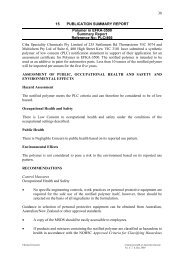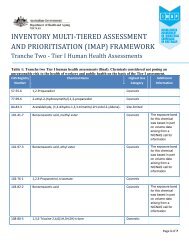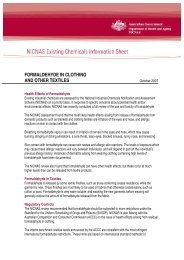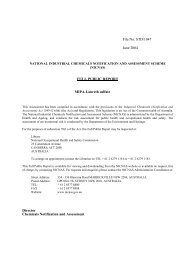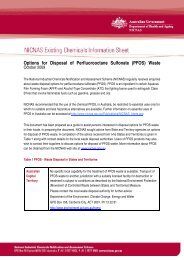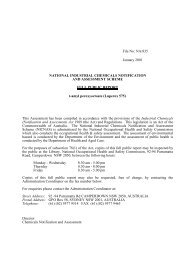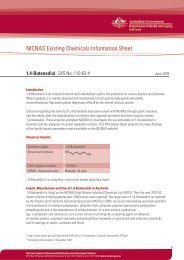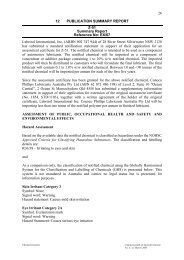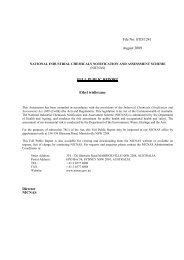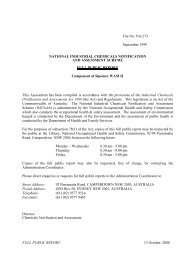GULFTENE C16-18 ISOMERISED OLEFINS - NICNAS
GULFTENE C16-18 ISOMERISED OLEFINS - NICNAS
GULFTENE C16-18 ISOMERISED OLEFINS - NICNAS
You also want an ePaper? Increase the reach of your titles
YUMPU automatically turns print PDFs into web optimized ePapers that Google loves.
10.1.a 1-tetradecene<br />
Fish Acute Toxicity Test (Wildlife International Ltd 1995)<br />
Range finding tests on rainbow trout were performed using WAF of the test substance made<br />
up in filtered well water (no chlorine) at nominal loadings of 0 (control), 10, 100 and 1 000<br />
mg/L in accordance with OECD TG 303. The WAF test media were made up by stirring the<br />
requisite quantity of test substance into the water for around 24 hours, allowing to settle for<br />
approximately one hour, and then siphoning of the aqueous phase containing the WAF. The<br />
WAFs prepared in this manner were clear and colourless, and apparently devoid of<br />
undissolved material or oil droplets. The tests were conducted over a 96 hour period at a<br />
controlled temperature of 15±2°C, and the test media was replaced daily in a batchwise<br />
manner. Five fish were tested at each WAF loading, and no mortalities or behavioural<br />
aberrations were observed over the duration of the tests.<br />
A definitive study was performed in duplicate using a control and the 1 000 mg/L WAF, with<br />
seven fish in each test vessel. The pH was always between 7.7 and 8.4, the temperature was<br />
15±2°C, water hardness around 140 mg/L as CaCO3 and the dissolved oxygen levels between<br />
5.2 and 9.3 mg/L. Again, no deaths or other effects were observed in the test specimens. It is<br />
concluded that the test substance is not toxic to this species of fish, up to the limits of its<br />
water solubility.<br />
Acute Immobilisation Test (Wildlife International Ltd 1995)<br />
The range finding test for acute immobilisation for Daphnia magna was performed over 48<br />
hours using WAFs of the test substance made up in filtered well water at nominal loadings of<br />
0 (control), 10, 100 and 1 000 mg/L, and ten daphnia were tested at each concentration. The<br />
temperature was maintained at 20±1°C, and no irreversible immobilisation or other<br />
behavioural aberrations were observed over the 48 hour test period. A definitive test was<br />
performed using a WAF containing 1 000 mg/L of test substance. Four replicate tests were<br />
run, together with one control, with five daphnia per test vessel. Temperature was maintained<br />
at 20±1°C, pH was always between 8.4±0.1, while dissolved oxygen levels were between 7.9<br />
and 8.1 mg/L. As with the range finding tests, no immobilisation or other effects were<br />
observed, and it is concluded that the test substance is not toxic to the daphnia up to the limits<br />
of its water solubility.<br />
Alga Growth Inhibition Test (Wildlife International Ltd 1995)<br />
Range finding tests on the green alga Selanastrum capricornutum with WAFs prepared at<br />
nominal loadings of up to 1 000 mg/L established that less than 50% inhibition of growth<br />
occurred up to the highest loading. Accordingly, the definitive test was conducted using only<br />
the WAF containing 1 000 mg/L, together with controls. Three replicates of the WAF<br />
containing medium were conducted, while six replicates of the control were used. The tests<br />
was performed over a 96 hour incubation period at 23±0.5°C at pH 7.4-8.7, and both algal<br />
biomass and the rate of biomass growth were measured. For the control group, greater than<br />
16 fold increase in biomass took place over three days as reckoned from the area under the<br />
growth curve. However, for the WAF-containing group the growth was slightly attenuated,<br />
FULL PUBLIC REPORT 26 April 2000<br />
NA/713 Page 78 of 100



